Monitoring of Woody Biomass Quality in Italy over a Five-Year Period to Support Sustainability
Abstract
:1. Introduction
2. Materials and Methods
2.1. Descriptive Statistics and Quality Mapping
2.2. Parametric and Non-Parametric Statistics
2.3. Multivariate Analysis
3. Results and Discussions
3.1. Descriptive, Parametric, and Non-Parametric Statistics
3.1.1. Moisture Content
3.1.2. Net Heating Value
3.1.3. Ash Content
3.1.4. Nitrogen Content
3.1.5. Carbon, Hydrogen, Chlorine, and Sulphur Contents
3.2. Multivariate Analysis Results
3.3. Closing Discussion
4. Conclusions
Author Contributions
Funding
Data Availability Statement
Conflicts of Interest
References
- Report from the Commission to the European Parliament, the Council, the European Economic and Social Committee and the Committee of the Regions—State of the Energy Union Report 2023 (Pursuant to Regulation (EU) 2018/1999 on the Governance of the Energy Union and Climate Action), Brussel. Available online: https://eur-lex.europa.eu/legal-content/EN/TXT/?uri=CELEX%3A52023DC0650 (accessed on 14 June 2024).
- Toscano, G.; De Francesco, C.; Gasperini, T.; Fabrizi, S.; Duca, D.; Ilari, A. Quality Assessment and Classification of Feedstock for Bioenergy Applications Considering ISO 17225 Standard on Solid Biofuels. Resources 2023, 12, 69. [Google Scholar] [CrossRef]
- Eurostat Data Browser—Volume of Timber (FAO, FE). Available online: https://ec.europa.eu (accessed on 15 June 2024).
- Eurostat Data Browser—Area of Wooded Land (FAO, FE). Available online: https://ec.europa.eu (accessed on 14 June 2024).
- Moliner, C.; Marchelli, F.; Arato, E. Current Status of Energy Production from Solid Biomass in North-West Italy. Energies 2020, 13, 4390. [Google Scholar] [CrossRef]
- Moliner, C.; Arato, E.; Marchelli, F. Current Status of Energy Production from Solid Biomass in Southern Italy. Energies 2021, 14, 2576. [Google Scholar] [CrossRef]
- Del Giudice, A.; Scarfone, A.; Paris, E.; Gallucci, F.; Santangelo, E. Harvesting Wood Residues for Energy Production from an Oak Coppice in Central Italy. Energies 2022, 15, 9444. [Google Scholar] [CrossRef]
- Proto, A.R.; Macrì, G.; Visser, R.; Harrill, H.; Russo, D.; Zimbalatti, G. Factors Affecting Forwarder Productivity. Eur. J. Res. 2018, 137, 143–151. [Google Scholar] [CrossRef]
- European Commission. Directorate-General for Research and Innovation, European Green Deal—Research & Innovation Call; Publications Office of the European Union: Luxembourg, 2021.
- Diego, R.; Giorgio, M.; Giuseppe, L.; Alessandro, D.R. Wood Energy Plants and Biomass Supply Chain in Southern Italy. Procedia Soc. Behav. Sci. 2016, 223, 849–856. [Google Scholar] [CrossRef]
- La Scalia, G.; Adelfio, L.; La Fata, C.M.; Micale, R. Economic and Environmental Assessment of Biomass Power Plants in Southern Italy. Sustainability 2022, 14, 9676. [Google Scholar] [CrossRef]
- He, J.; Liu, Y.; Lin, B. Should China Support the Development of Biomass Power Generation? Energy 2018, 163, 416–425. [Google Scholar] [CrossRef]
- Evans, A.; Strezov, V.; Evans, T.J. Sustainability Considerations for Electricity Generation from Biomass. Renew. Sustain. Energy Rev. 2010, 14, 1419–1427. [Google Scholar] [CrossRef]
- Jåstad, E.O.; Bolkesjø, T.F.; Trømborg, E.; Rørstad, P.K. The Role of Woody Biomass for Reduction of Fossil GHG Emissions in the Future North European Energy Sector. Appl. Energy 2020, 274, 115360. [Google Scholar] [CrossRef]
- Sulaiman, C.; Abdul-Rahim, A.S.; Ofozor, C.A. Does Wood Biomass Energy Use Reduce CO2 Emissions in European Union Member Countries? Evidence from 27 Members. J. Clean. Prod. 2020, 253, 119996. [Google Scholar] [CrossRef]
- Antar, M.; Lyu, D.; Nazari, M.; Shah, A.; Zhou, X.; Smith, D.L. Biomass for a Sustainable Bioeconomy: An Overview of World Biomass Production and Utilization. Renew. Sustain. Energy Rev. 2021, 139, 110691. [Google Scholar] [CrossRef]
- Reijnders, L. Conditions for the Sustainability of Biomass Based Fuel Use. Energy Policy 2006, 34, 863–876. [Google Scholar] [CrossRef]
- Klavina, A.; Selegovskis, R. Influence of Wood Chip Quality on Boiler House Efficiency. Eng. Rural. Dev. 2021, 20, 393–398. [Google Scholar] [CrossRef]
- Schön, C.; Kuptz, D.; Mack, R.; Zelinski, V.; Loewen, A.; Hartmann, H. Influence of Wood Chip Quality on Emission Behaviour in Small-Scale Wood Chip Boilers. Biomass Convers. Biorefin. 2019, 9, 71–82. [Google Scholar] [CrossRef]
- Proto, A.R.; Palma, A.; Paris, E.; Papandrea, S.F.; Vincenti, B.; Carnevale, M.; Guerriero, E.; Bonofiglio, R.; Gallucci, F. Assessment of Wood Chip Combustion and Emission Behavior of Different Agricultural Biomasses. Fuel 2021, 289, 119758. [Google Scholar] [CrossRef]
- Dzurenda, L.; Banski, A. The Effect of Firewood Moisture Content on the Atmospheric Thermal Load by Flue Gases Emitted by a Boiler. Sustainability 2019, 11, 284. [Google Scholar] [CrossRef]
- Chen, Q.; Zhang, X.; Zhou, J.; Sharifi, V.N.; Swithenbank, J. Effects of Flue Gas Recirculation on Emissions from a Small Scale Wood Chip Fired Boiler. Phys. Procedia 2015, 66, 65–68. [Google Scholar] [CrossRef]
- DBFZ (Deutsches Biomasseforschungszentrum Gemeinnützige GmbH). Model Contract for Biomass Delivery. Horizon 2020 Coordination and Support Action No. 646495: Bioenergy for Business. Uptake of Solid Bioenergy in European Commercial Sectors. 2015. Available online: https://ec.europa.eu/research/participants/documents/downloadPublic?documentIds=080166e5a191c345&appId=PPGMS (accessed on 14 June 2024).
- Lieskovský, M.; Jankovský, M.; Trenčiansky, M.; Merganič, J.; Dvořák, J. Ash Content vs. the Economics of Using Wood Chips for Energy: Model Based on Data from Central Europe. Bioresources 2017, 12, 1579–1592. [Google Scholar] [CrossRef]
- ISO 17225-1:2014; Solid Biofuels: Fuel Specifications and Classes. International Organization for Standardization: Geneva, Switzerland, 2014.
- ISO 17225-9:2019; Solid Biofuels: Fuel Specifications and Classes—Part 9: Graded Hog Fuel and Wood Chips for Industrial Use. International Organization for Standardization: Geneva, Switzerland, 2014.
- ISO 18134; Solid Biofuels-Determination of Moisture Content-Oven Dry Method-Part 2. International Organization for Standardization: Geneva, Switzerland, 2015.
- ISO 18122; Solid Biofuels-Determination of Ash Content. International Organization for Standardization: Geneva, Switzerland, 2015.
- ISO 18125; Solid Biofuels-Determination of Calorific Value. International Organization for Standardization: Geneva, Switzerland, 2017.
- ISO 16948; Solid Biofuels-Determination of Total Content of Carbon, Hydrogen and Nitrogen. International Organization for Standardization: Geneva, Switzerland, 2015.
- ISO 16994; Solid Biofuels-Determination of Total Content of Sulfur and Chlorine. International Organization for Standardization: Geneva, Switzerland, 2015.
- McKinney, W. Data Structures for Statistical Computing in Python. In Proceedings of the 9th Python in Science Conference 2010, Austin, TX, USA, 28–30 June 2010; pp. 56–61. [Google Scholar] [CrossRef]
- Virtanen, P.; Gommers, R.; Oliphant, T.E.; Haberland, M.; Reddy, T.; Cournapeau, D.; Burovski, E.; Peterson, P.; Weckesser, W.; Bright, J.; et al. SciPy 1.0: Fundamental Algorithms for Scientific Computing in Python. Nat. Methods 2020, 17, 261–272. [Google Scholar] [CrossRef] [PubMed]
- Hunter, J.D. Matplotlib: A 2D Graphics Environment. Comput. Sci. Eng. 2007, 9, 90–95. [Google Scholar] [CrossRef]
- Seabold, S.; Perktold, J. Statsmodels: Econometric and Statistical Modeling with Python. In Proceedings of the 9th Python in Science Conference 2010, Austin, TX, USA, 28–30 June 2010; pp. 92–96. [Google Scholar] [CrossRef]
- Toscano, G.; Rinnan, Å.; Pizzi, A.; Mancini, M. The Use of Near-Infrared (NIR) Spectroscopy and Principal Component Analysis (PCA) to Discriminate Bark and Wood of the Most Common Species of the Pellet Sector. Energy Fuels 2017, 31, 2814–2821. [Google Scholar] [CrossRef]
- Popescu, C.M.; Navi, P.; Placencia Peña, M.I.; Popescu, M.C. Structural Changes of Wood during Hydro-Thermal and Thermal Treatments Evaluated through NIR Spectroscopy and Principal Component Analysis. Spectrochim. Acta A Mol. Biomol. Spectrosc. 2018, 191, 405–412. [Google Scholar] [CrossRef] [PubMed]
- Jorgensen, A. Clustering Excipient Near Infrared Spectra Using Different Chemometric Methods; Technical Report; Department of Pharmacy, University of Helsinki: Helsinki, Finland, 2000. [Google Scholar]
- Anderson, T.W.; Darling, D.A. A Test of Goodness of Fit. J. Am. Stat. Assoc. 1954, 49, 765–769. [Google Scholar] [CrossRef]
- Kozak, M.; Piepho, H.P. What’s Normal Anyway? Residual Plots Are More Telling than Significance Tests When Checking ANOVA Assumptions. J. Agron. Crop Sci. 2018, 204, 86–98. [Google Scholar] [CrossRef]
- Doane, D.P.; Seward, L.E. Measuring Skewness: A Forgotten Statistic? J. Stat. Educ. 2011, 19. [Google Scholar] [CrossRef]
- Nanda, A.; Mohapatra, B.B.; Mahapatra, A.P.K.; Mahapatra, A.P.K.; Mahapatra, A.P.K. Multiple Comparison Test by Tukey’s Honestly Significant Difference (HSD): Do the Confident Level Control Type I Error. Int. J. Stat. Appl. Math. 2021, 6, 59–65. [Google Scholar] [CrossRef]
- Salminen, J.; Sairanen, H.; Patel, S.; Ojanen-Saloranta, M.; Kajastie, H.; Palkova, Z.; Heinonen, M. Effects of Sample Handling and Transportation on the Moisture Content of Biomass Samples. Int. J. Thermophys. 2018, 39, 66. [Google Scholar] [CrossRef]
- ISO 18135:2017; Solid Biofuels-Sampling BSI Standards Publication. International Organization for Standardization: Geneva, Switzerland, 2017.
- Q-Q Plot (Quantile to Quantile Plot). The Concise Encyclopedia of Statistics; Springer: New York, NY, USA, 2008; pp. 437–439. [Google Scholar] [CrossRef]
- Demirbas, A. Effects of Moisture and Hydrogen Content on the Heating Value of Fuels. Energy Sources Part A Recovery Util. Environ. Eff. 2007, 29, 649–655. [Google Scholar] [CrossRef]
- McKight, P.E.; Najab, J. Kruskal-Wallis Test. The Corsini Encyclopedia of Psychology; John Wiley & Sons: Hoboken, NJ, USA, 2010; p. 1. [Google Scholar] [CrossRef]
- Dunn, O.J. Multiple Comparisons Using Rank Sums. Technometrics 1964, 6, 241–252. [Google Scholar] [CrossRef]
- Vassilev, S.V.; Vassileva, C.G.; Song, Y.C.; Li, W.Y.; Feng, J. Ash Contents and Ash-Forming Elements of Biomass and Their Significance for Solid Biofuel Combustion. Fuel 2017, 208, 377–409. [Google Scholar] [CrossRef]
- Nosek, R.; Holubcik, M.; Jandacka, J. The Impact of Bark Content of Wood Biomass on Biofuel Properties. Bioresources 2016, 11, 44–53. [Google Scholar] [CrossRef]
- Guidi, W.; Piccioni, E.; Ginanni, M.; Bonari, E. Bark Content Estimation in Poplar (Populus deltoides L.) short-rotation coppice in Central Italy. Biomass Bioenergy 2008, 32, 518–524. [Google Scholar] [CrossRef]
- Röser, D.; Mola-Yudego, B.; Sikanen, L.; Prinz, R.; Gritten, D.; Emer, B.; Väätäinen, K.; Erkkilä, A. Natural Drying Treatments during Seasonal Storage of Wood for Bioenergy in Different European Locations. Biomass Bioenergy 2011, 35, 4238–4247. [Google Scholar] [CrossRef]
- Maslova, S.P.; Tabalenkova, G.N.; Golovko, T.K. Respiration and Nitrogen and Carbohydrate Contents in Perennial Rhizome-Forming Plants as Related to Realization of Different Adaptive Strategies. Russ. J. Plant Physiol. 2010, 57, 631–640. [Google Scholar] [CrossRef]
- Bārdule, A.; Liepiņš, J.; Liepiņš, K.; Stola, J.; Butlers, A.; Lazdiņš, A. Variation in Carbon Content among the Major Tree Species in Hemiboreal Forests in Latvia. Forests 2021, 12, 1292. [Google Scholar] [CrossRef]
- Lee, J.S.; Ghiasi, B.; Lau, A.K.; Sokhansanj, S. Chlorine and Ash Removal from Salt-Laden Woody Biomass by Washing and Pressing. Biomass Bioenergy 2021, 155, 106272. [Google Scholar] [CrossRef]
- Han, K.; Gao, J.; Qi, J. The Study of Sulphur Retention Characteristics of Biomass Briquettes during Combustion. Energy 2019, 186, 115788. [Google Scholar] [CrossRef]
- Toscano, G.; Leoni, E.; Gasperini, T.; Picchi, G. Performance of a Portable NIR Spectrometer for the Determination of Moisture Content of Industrial Wood Chips Fuel. Fuel 2022, 320, 123948. [Google Scholar] [CrossRef]
- Leoni, E.; Mancini, M.; Duca, D.; Toscano, G. Rapid Quality Control of Woodchip Parameters Using a Hand-Held Near Infrared Spectrophotometer. Processes 2020, 8, 1413. [Google Scholar] [CrossRef]
- Nimitpaitoon, T.; Sajjakulnukit, B.; Prangbang, P. The Effect of Storage Conditions on the Characteristics of Various Types of Biomass. Int. J. Adv. Appl. Sci. 2023, 10, 130–139. [Google Scholar] [CrossRef]
- Brand, M.A.; Bolzon de Muñiz, G.I.; Quirino, W.F.; Brito, J.O. Storage as a Tool to Improve Wood Fuel Quality. Biomass Bioenergy 2011, 35, 2581–2588. [Google Scholar] [CrossRef]
- Parzych, A.; Mochnacký, S.; Sobisz, Z.; Polláková, N.; Šimanský, V. Needles and Bark of Picea abies (L.) H. Karst and Picea omorika (Pančiç) Purk. as Bioindicators of Environmental Quality. Folia For. Pol. Ser. A—For. 2018, 60, 230–240. [Google Scholar] [CrossRef]
- Werkelin, J.; Skrifvars, B.J.; Hupa, M. Ash-Forming Elements in Four Scandinavian Wood Species. Part 1: Summer Harvest. Biomass Bioenergy 2005, 29, 451–466. [Google Scholar] [CrossRef]
- Svensson, T.; Löfgren, A.; Saetre, P.; Kautsky, U.; Bastviken, D. Chlorine Distribution in Soil and Vegetation in Boreal Habitats along a Moisture Gradient from Upland Forest to Lake Margin Wetlands. Environ. Sci. Technol. 2023, 57, 11067–11074. [Google Scholar] [CrossRef]
- Patel, B.; Gami, B.; Patel, P. The Leaching of Soluble Chloride from Terrestrial and Water-Based Biomass. Energy Sources Part A Recovery Util. Environ. Eff. 2012, 34, 2280–2286. [Google Scholar] [CrossRef]
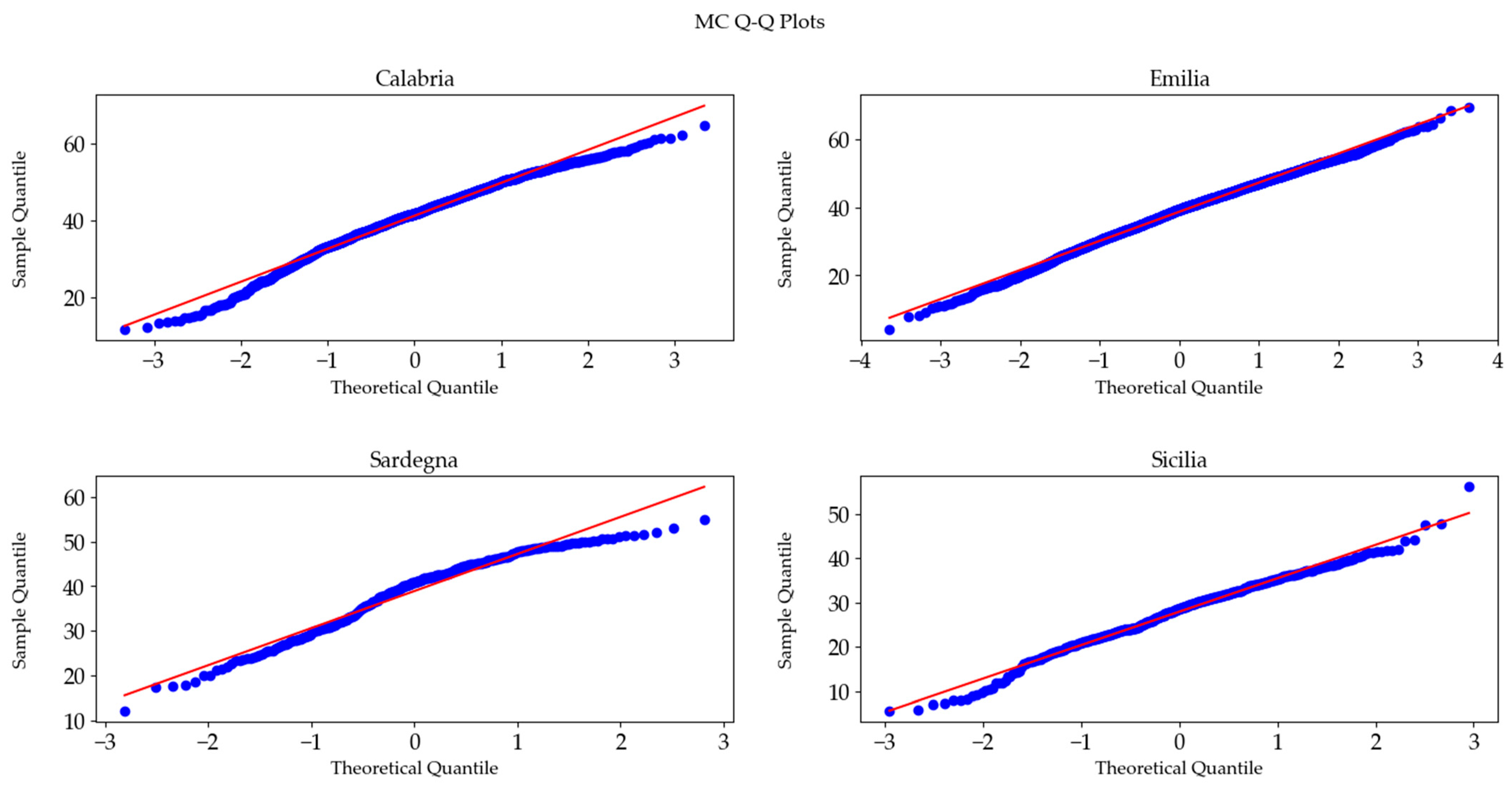

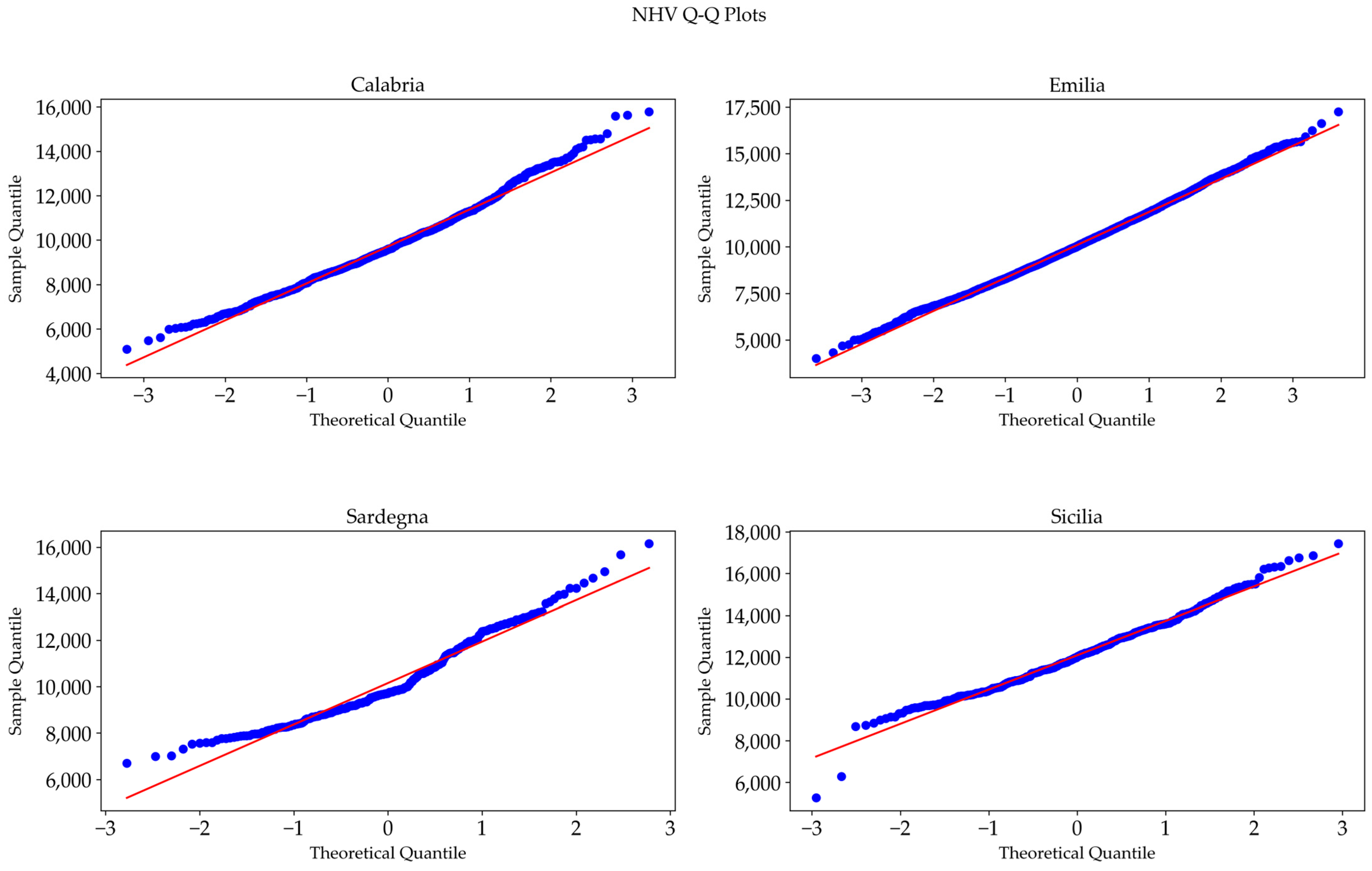
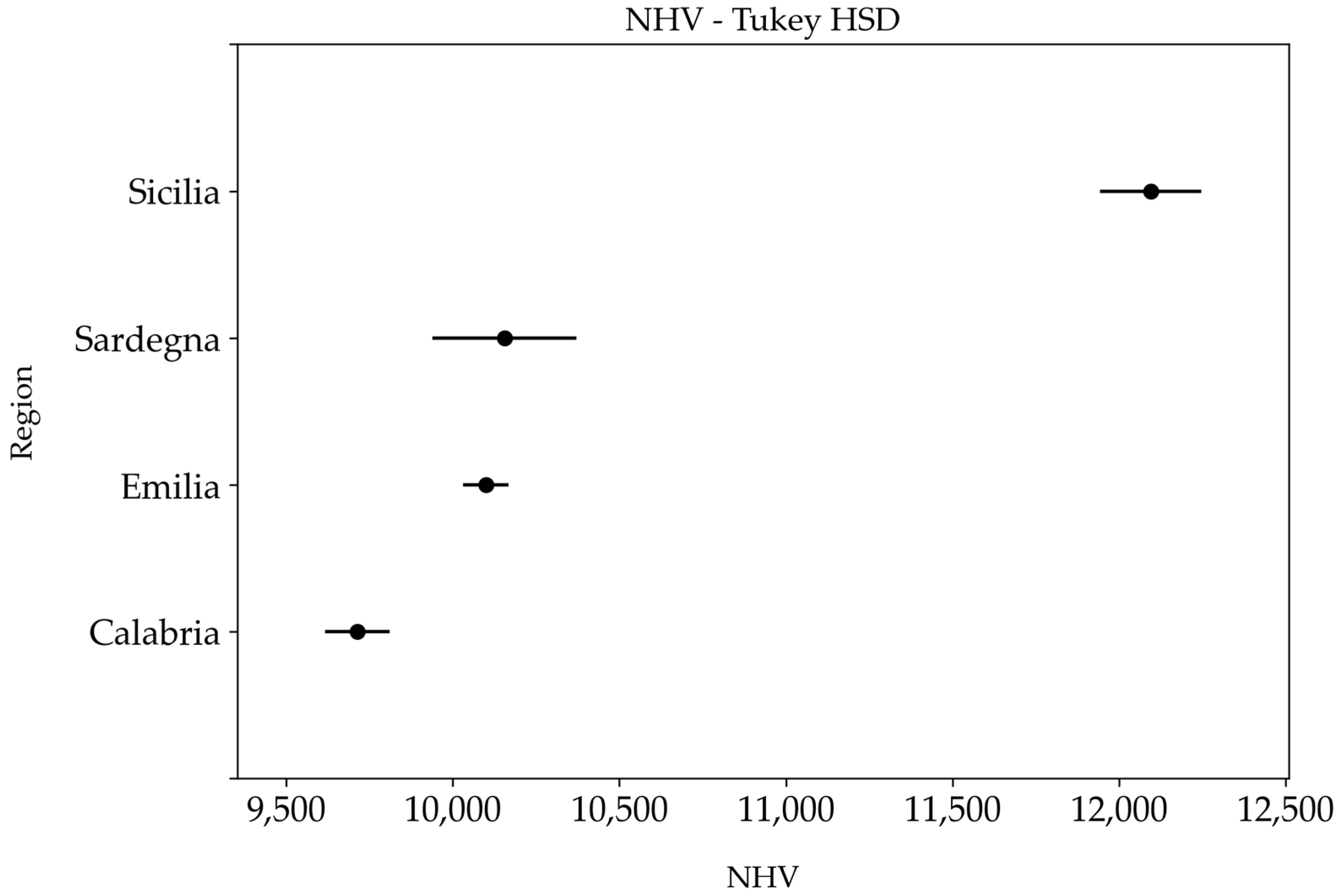



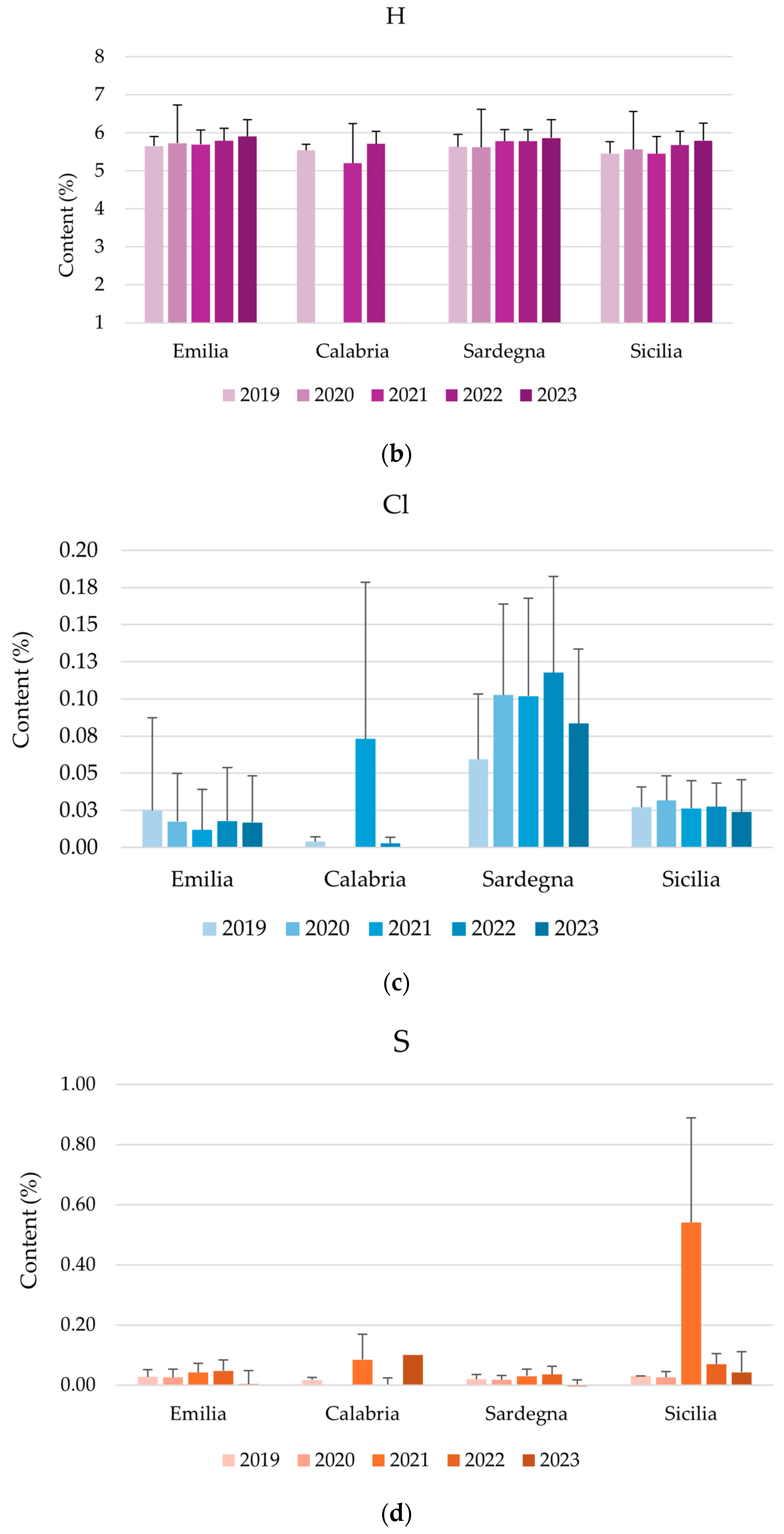



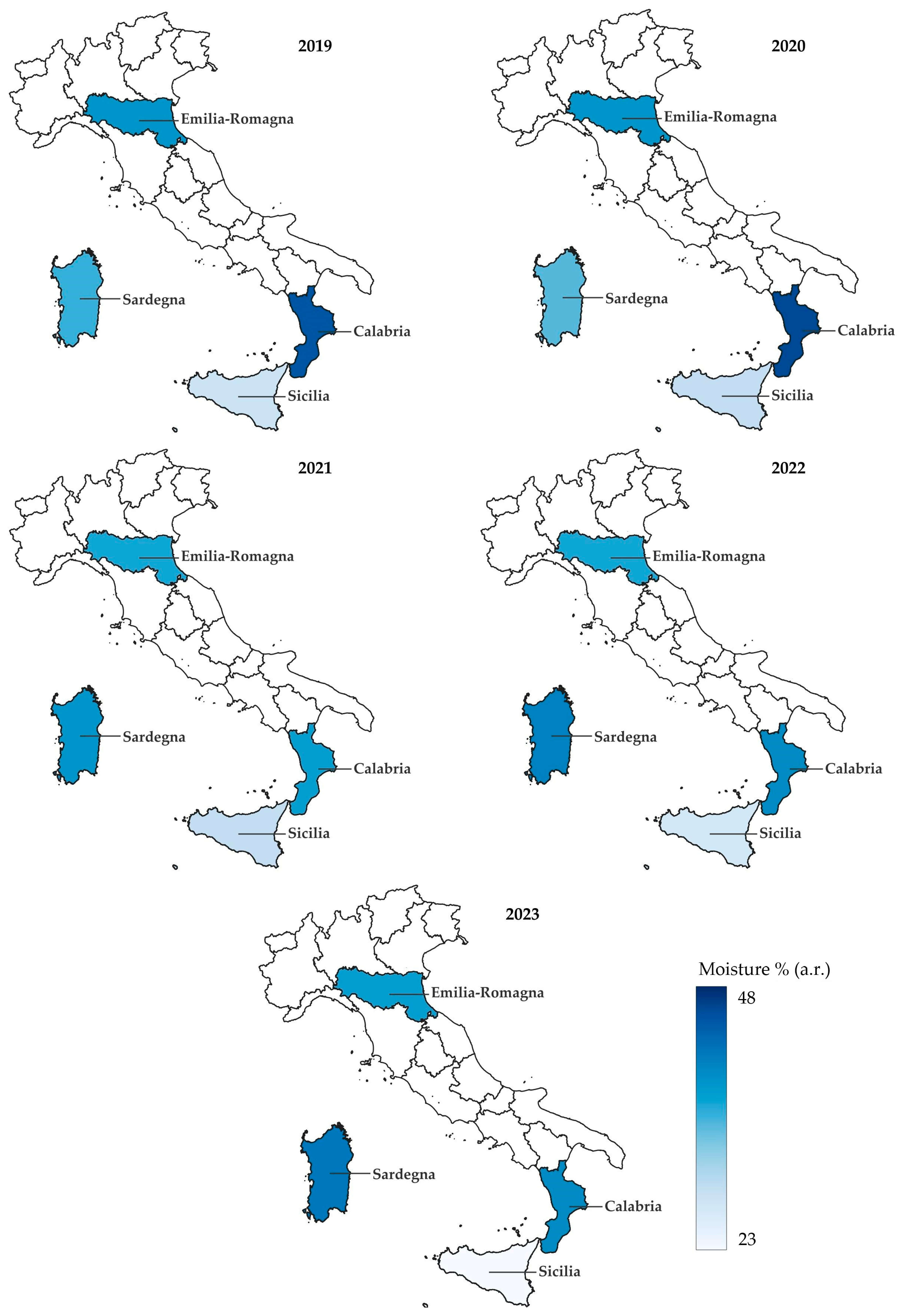
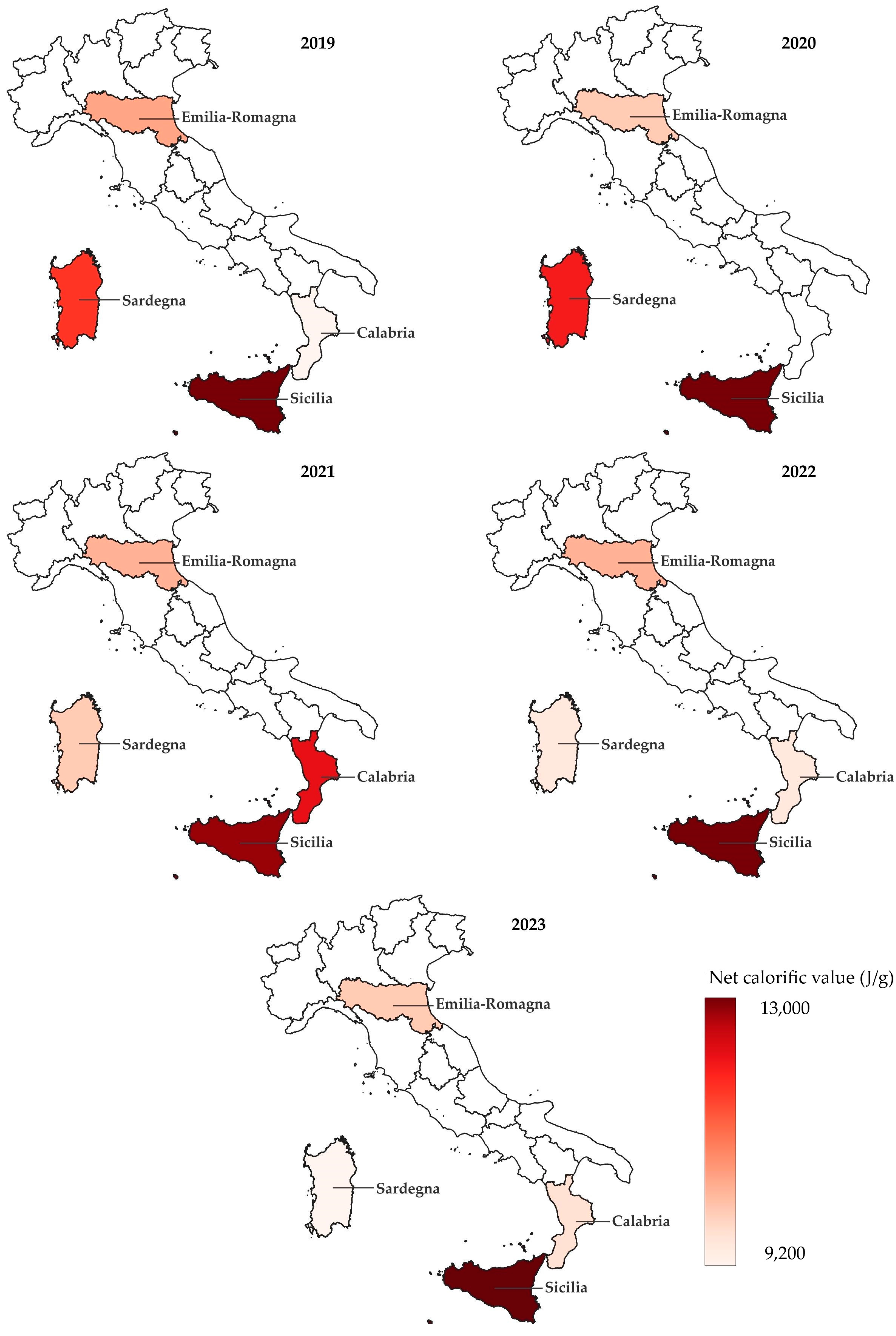
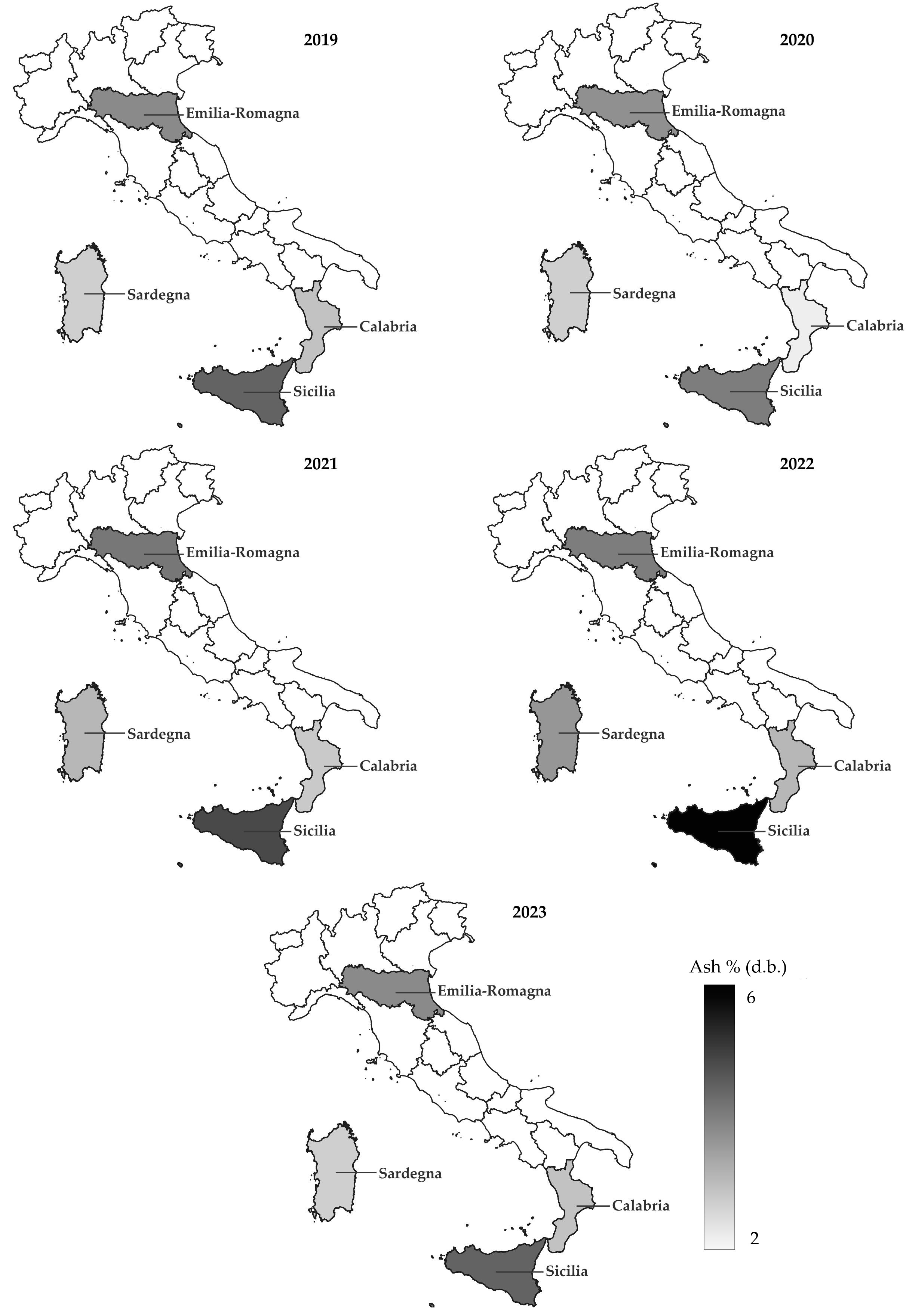
| Moisture Content (% a.r.) | |||||||
|---|---|---|---|---|---|---|---|
| Region | Year | N. Samples | Mean | St. Dev. | Q1 | Q2 | Q3 |
| EMILIA - ROMAGNA | 2019 | 465 | 39.3 | 7.8 | 34.2 | 40.7 | 44.3 |
| 2020 | 800 | 39.3 | 8.1 | 34.3 | 39.9 | 44.1 | |
| 2021 | 1143 | 37.8 | 8.3 | 34.4 | 40.3 | 45.2 | |
| 2022 | 1266 | 37.6 | 9.4 | 31.5 | 37.6 | 44.4 | |
| 2023 | 1437 | 38.3 | 8.3 | 32.7 | 38.6 | 44.2 | |
| 2019 | 123 | 45.3 | 7.6 | 41.8 | 45.9 | 49.4 | |
| 2020 | 91 | 46.5 | 7.5 | 41.6 | 47.5 | 52.2 | |
| CALABRIA | 2021 | 212 | 38.1 | 10.6 | 31.9 | 40.5 | 45.6 |
| 2022 | 622 | 40.7 | 7.7 | 36.1 | 41.2 | 45.9 | |
| 2023 | 594 | 41.0 | 8.5 | 35.5 | 41.2 | 47.3 | |
| 2019 | 72 | 36.8 | 7.3 | 30.8 | 38.2 | 42.4 | |
| 2020 | 48 | 35.7 | 8.9 | 30.1 | 36.6 | 42.6 | |
| SARDEGNA | 2021 | 56 | 39.2 | 7.9 | 34.5 | 40.1 | 44.6 |
| 2022 | 58 | 41.0 | 9.1 | 35.7 | 44.4 | 48.2 | |
| 2023 | 46 | 42.7 | 7.4 | 40.6 | 44.8 | 48.0 | |
| 2019 | 94 | 28.7 | 7.1 | 23.9 | 30.4 | 34.1 | |
| 2020 | 89 | 29.3 | 6.3 | 24.9 | 28.6 | 33.6 | |
| SICILIA | 2021 | 98 | 29.6 | 8.0 | 22.7 | 30.3 | 36.2 |
| 2022 | 91 | 27.3 | 7.7 | 23.3 | 28.0 | 31.6 | |
| 2023 | 68 | 23.5 | 7.1 | 19.0 | 23.1 | 28.6 | |
| Net Heating Value (J/g a.r.) | |||||||
|---|---|---|---|---|---|---|---|
| Year | N. Samples | Mean | St. Dev. | Q1 | Q2 | Q3 | |
| EMILIA - ROMAGNA | 2019 | 315 | 10,421 | 1590 | 9330 | 10,360 | 11,556 |
| 2020 | 800 | 10,052 | 1611 | 9058 | 10,038 | 11,020 | |
| 2021 | 1197 | 10,277 | 1707 | 8669 | 9816 | 10,966 | |
| 2022 | 1266 | 10,258 | 2009 | 8748 | 10,207 | 11,612 | |
| 2023 | 1427 | 10,086 | 1733 | 8885 | 10,031 | 11,253 | |
| CALABRIA | 2019 | 10 | 9280 | 515 | 8847 | 9505 | 9609 |
| / | |||||||
| 2021 | 11 | 11,102 | 2279 | 9816 | 11,588 | 11,773 | |
| 2022 | 516 | 9676 | 1622 | 8627 | 9569 | 10,598 | |
| 2023 | 496 | 9731 | 1705 | 8542 | 9573 | 10,840 | |
| SARDEGNA | 2019 | 52 | 10,673 | 1411 | 9534 | 10,423 | 11,763 |
| 2020 | 48 | 11,005 | 1915 | 9521 | 10,707 | 12,393 | |
| 2021 | 46 | 10,045 | 1640 | 9067 | 9838 | 11,013 | |
| 2022 | 58 | 9669 | 1946 | 8311 | 8832 | 10,896 | |
| 2023 | 46 | 9406 | 1619 | 8244 | 8930 | 9740 | |
| SICILIA | 2019 | 94 | 12,028 | 1537 | 10,884 | 11,712 | 12,990 |
| 2020 | 89 | 11,979 | 1349 | 11,018 | 11,981 | 12,893 | |
| 2021 | 98 | 11,746 | 1767 | 10,279 | 11,518 | 13,381 | |
| 2022 | 91 | 12,024 | 1737 | 10,900 | 12,108 | 13,148 | |
| 2023 | 68 | 12,934 | 1628 | 11,710 | 12,941 | 13,992 | |
| Ash (% d.b.) | |||||||
|---|---|---|---|---|---|---|---|
| Year | N. Samples | Mean | St. Dev. | Q1 | Q2 | Q3 | |
| EMILIA - ROMAGNA | 2019 | 504 | 4.4 | 2.5 | 2.8 | 3.9 | 5.38 |
| 2020 | 856 | 4.4 | 3.3 | 2.2 | 3.8 | 5.57 | |
| 2021 | 1197 | 4.7 | 3.4 | 2.7 | 4.2 | 6.07 | |
| 2022 | 1325 | 5.1 | 4.0 | 2.8 | 4.1 | 6.15 | |
| 2023 | 1474 | 4.9 | 3.8 | 2.6 | 3.9 | 5.87 | |
| CALABRIA | 2019 | 40 | 4.5 | 4.2 | 1.6 | 2.7 | 6.6 |
| 2020 | 36 | 4.5 | 7.6 | 1.8 | 2.3 | 3.3 | |
| 2021 | 63 | 4.8 | 6.0 | 2.1 | 2.9 | 5.0 | |
| 2022 | 562 | 4.4 | 4.1 | 2.1 | 3.2 | 5.2 | |
| 2023 | 558 | 4.0 | 3.7 | 1.9 | 3.0 | 4.7 | |
| SARDEGNA | 2019 | 52 | 2.7 | 1.0 | 2.0 | 2.5 | 3.3 |
| 2020 | 48 | 2.7 | 1.3 | 1.8 | 2.8 | 3.3 | |
| 2021 | 46 | 3.3 | 1.9 | 2.2 | 3.2 | 3.9 | |
| 2022 | 58 | 4.0 | 2.1 | 2.6 | 3.7 | 4.9 | |
| 2023 | 46 | 2.9 | 1.3 | 1.9 | 2.8 | 3.7 | |
| SICILIA | 2019 | 94 | 5.5 | 2.7 | 3.6 | 5.0 | 6.8 |
| 2020 | 89 | 4.9 | 3.2 | 3.3 | 4.1 | 5.2 | |
| 2021 | 98 | 6.2 | 4.2 | 3.6 | 4.9 | 7.1 | |
| 2022 | 91 | 6.9 | 3.8 | 4.5 | 6.1 | 7.6 | |
| 2023 | 68 | 4.8 | 2.1 | 3.2 | 4.5 | 5.6 | |
| Macro Division | Database | N. Samples |
|---|---|---|
| SA | 2019 | 338 |
| 2020 | 490 | |
| 2021 | 687 | |
| 2022 | 363 | |
| 2023 | 409 | |
| TA | Emilia | 1699 |
| Calabria | 38 | |
| Sardegna | 110 | |
| Sicilia | 440 |
| Variable | MC | NHV | ASH | HHV | LHV | C | H | N | OX | CL | S |
|---|---|---|---|---|---|---|---|---|---|---|---|
| MC | 1.000 | ||||||||||
| NHV | −0.961 | 1.000 | |||||||||
| ASH | 0.021 | −0.223 | 1.000 | ||||||||
| HHV | 0.091 | 0.164 | −0.802 | 1.000 | |||||||
| LHV | 0.094 | 0.181 | −0.743 | 0.941 | 1.000 | ||||||
| C | 0.014 | 0.144 | −0.628 | 0.624 | 0.580 | 1.000 | |||||
| H | −0.012 | −0.057 | −0.142 | 0.137 | −0.205 | 0.109 | 1.000 | ||||
| N | −0.021 | −0.056 | 0.332 | −0.304 | −0.272 | −0.274 | −0.083 | 1.000 | |||
| OX | −0.031 | 0.148 | −0.536 | 0.309 | 0.410 | −0.247 | −0.315 | −0.183 | 1.000 | ||
| CL | −0.125 | 0.108 | 0.099 | −0.064 | −0.052 | −0.035 | −0.033 | 0.106 | −0.086 | 1.000 | |
| S | −0.069 | 0.033 | 0.208 | −0.139 | −0.132 | −0.076 | −0.016 | 0.177 | −0.193 | 0.173 | 1.000 |
| MC | NHV | ASH | HHV | LHV | C | H | N | OX | CL | S | |
|---|---|---|---|---|---|---|---|---|---|---|---|
| MC | 1.000 | ||||||||||
| NHV | −0.956 | 1.000 | |||||||||
| ASH | 0.285 | −0.478 | 1.000 | ||||||||
| HHV | −0.127 | 0.407 | −0.789 | 1.000 | |||||||
| LHV | −0.115 | 0.399 | −0.754 | 0.992 | 1.000 | ||||||
| C | −0.226 | 0.397 | −0.764 | 0.697 | 0.650 | 1.000 | |||||
| H | −0.126 | 0.192 | −0.516 | 0.390 | 0.273 | 0.583 | 1.000 | ||||
| N | 0.138 | −0.148 | 0.176 | −0.107 | −0.089 | −0.184 | −0.171 | 1.000 | |||
| OX | −0.250 | 0.266 | −0.214 | 0.112 | 0.120 | −0.012 | −0.022 | −0.062 | 1.000 | ||
| CL | −0.011 | 0.013 | 0.075 | −0.012 | −0.007 | −0.033 | −0.040 | 0.224 | −0.099 | 1.000 | |
| S | 0.149 | −0.127 | −0.046 | 0.044 | 0.044 | −0.007 | 0.017 | 0.007 | −0.831 | 0.081 | 1.000 |
Disclaimer/Publisher’s Note: The statements, opinions and data contained in all publications are solely those of the individual author(s) and contributor(s) and not of MDPI and/or the editor(s). MDPI and/or the editor(s) disclaim responsibility for any injury to people or property resulting from any ideas, methods, instructions or products referred to in the content. |
© 2024 by the authors. Licensee MDPI, Basel, Switzerland. This article is an open access article distributed under the terms and conditions of the Creative Commons Attribution (CC BY) license (https://creativecommons.org/licenses/by/4.0/).
Share and Cite
Gasperini, T.; Leoni, E.; Duca, D.; De Francesco, C.; Toscano, G. Monitoring of Woody Biomass Quality in Italy over a Five-Year Period to Support Sustainability. Resources 2024, 13, 115. https://doi.org/10.3390/resources13090115
Gasperini T, Leoni E, Duca D, De Francesco C, Toscano G. Monitoring of Woody Biomass Quality in Italy over a Five-Year Period to Support Sustainability. Resources. 2024; 13(9):115. https://doi.org/10.3390/resources13090115
Chicago/Turabian StyleGasperini, Thomas, Elena Leoni, Daniele Duca, Carmine De Francesco, and Giuseppe Toscano. 2024. "Monitoring of Woody Biomass Quality in Italy over a Five-Year Period to Support Sustainability" Resources 13, no. 9: 115. https://doi.org/10.3390/resources13090115






